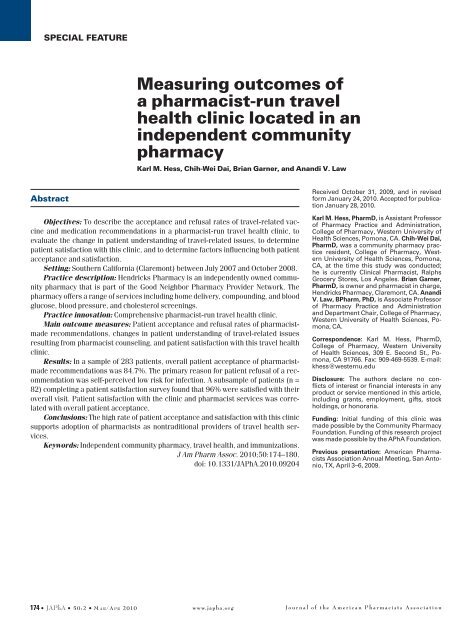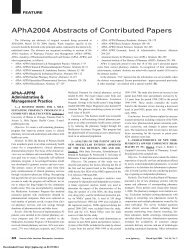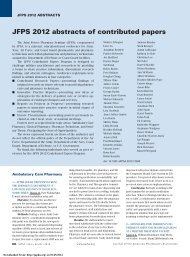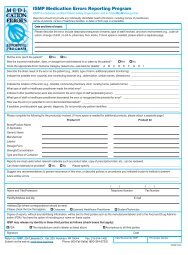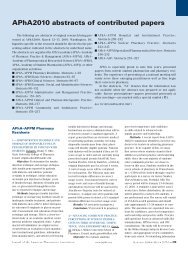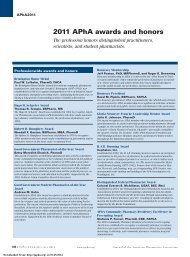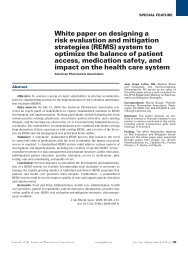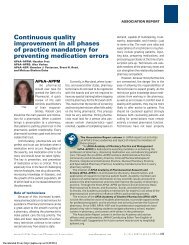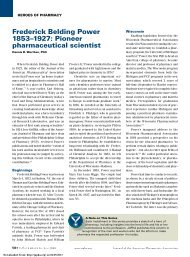Measuring outcomes of a pharmacist-run travel health clinic located ...
Measuring outcomes of a pharmacist-run travel health clinic located ...
Measuring outcomes of a pharmacist-run travel health clinic located ...
Create successful ePaper yourself
Turn your PDF publications into a flip-book with our unique Google optimized e-Paper software.
SPECIAL FEATURE<br />
Abstract<br />
Objectives: To describe the acceptance and refusal rates <strong>of</strong> <strong>travel</strong>-related vaccine<br />
and medication recommendations in a <strong>pharmacist</strong>-<strong>run</strong> <strong>travel</strong> <strong>health</strong> <strong>clinic</strong>, to<br />
evaluate the change in patient understanding <strong>of</strong> <strong>travel</strong>-related issues, to determine<br />
patient satisfaction with this <strong>clinic</strong>, and to determine factors influencing both patient<br />
acceptance and satisfaction.<br />
Setting: Southern California (Claremont) between July 2007 and October 2008.<br />
Practice description: Hendricks Pharmacy is an independently owned community<br />
pharmacy that is part <strong>of</strong> the Good Neighbor Pharmacy Provider Network. The<br />
pharmacy <strong>of</strong>fers a range <strong>of</strong> services including home delivery, compounding, and blood<br />
glucose, blood pressure, and cholesterol screenings.<br />
Practice innovation: Comprehensive <strong>pharmacist</strong>-<strong>run</strong> <strong>travel</strong> <strong>health</strong> <strong>clinic</strong>.<br />
Main outcome measures: Patient acceptance and refusal rates <strong>of</strong> <strong>pharmacist</strong>made<br />
recommendations, changes in patient understanding <strong>of</strong> <strong>travel</strong>-related issues<br />
resulting from <strong>pharmacist</strong> counseling, and patient satisfaction with this <strong>travel</strong> <strong>health</strong><br />
<strong>clinic</strong>.<br />
Results: In a sample <strong>of</strong> 283 patients, overall patient acceptance <strong>of</strong> <strong>pharmacist</strong>made<br />
recommendations was 84.7%. The primary reason for patient refusal <strong>of</strong> a recommendation<br />
was self-perceived low risk for infection. A subsample <strong>of</strong> patients (n =<br />
82) completing a patient satisfaction survey found that 96% were satisfied with their<br />
overall visit. Patient satisfaction with the <strong>clinic</strong> and <strong>pharmacist</strong> services was correlated<br />
with overall patient acceptance.<br />
Conclusions: The high rate <strong>of</strong> patient acceptance and satisfaction with this <strong>clinic</strong><br />
supports adoption <strong>of</strong> <strong>pharmacist</strong>s as nontraditional providers <strong>of</strong> <strong>travel</strong> <strong>health</strong> services.<br />
Keywords: Independent community pharmacy, <strong>travel</strong> <strong>health</strong>, and immunizations.<br />
J Am Pharm Assoc. 2010;50:174–180.<br />
doi: 10.1331/JAPhA.2010.09204<br />
174 • JAPhA • 50:2 • M a r/apr 2010<br />
<strong>Measuring</strong> <strong>outcomes</strong> <strong>of</strong><br />
a <strong>pharmacist</strong>-<strong>run</strong> <strong>travel</strong><br />
<strong>health</strong> <strong>clinic</strong> <strong>located</strong> in an<br />
independent community<br />
pharmacy<br />
Karl M. Hess, Chih-Wei Dai, Brian Garner, and Anandi V. Law<br />
www.japha.org<br />
Received October 31, 2009, and in revised<br />
form January 24, 2010. Accepted for publication<br />
January 28, 2010.<br />
Karl M. Hess, PharmD, is Assistant Pr<strong>of</strong>essor<br />
<strong>of</strong> Pharmacy Practice and Administration,<br />
College <strong>of</strong> Pharmacy, Western University <strong>of</strong><br />
Health Sciences, Pomona, CA. Chih-Wei Dai,<br />
PharmD, was a community pharmacy practice<br />
resident, College <strong>of</strong> Pharmacy, Western<br />
University <strong>of</strong> Health Sciences, Pomona,<br />
CA, at the time this study was conducted;<br />
he is currently Clinical Pharmacist, Ralphs<br />
Grocery Stores, Los Angeles. Brian Garner,<br />
PharmD, is owner and <strong>pharmacist</strong> in charge,<br />
Hendricks Pharmacy, Claremont, CA. Anandi<br />
V. Law, BPharm, PhD, is Associate Pr<strong>of</strong>essor<br />
<strong>of</strong> Pharmacy Practice and Administration<br />
and Department Chair, College <strong>of</strong> Pharmacy,<br />
Western University <strong>of</strong> Health Sciences, Pomona,<br />
CA.<br />
Correspondence: Karl M. Hess, PharmD,<br />
College <strong>of</strong> Pharmacy, Western University<br />
<strong>of</strong> Health Sciences, 309 E. Second St., Pomona,<br />
CA 91766. Fax: 909-469-5539. E-mail:<br />
khess@westernu.edu<br />
Disclosure: The authors declare no conflicts<br />
<strong>of</strong> interest or financial interests in any<br />
product or service mentioned in this article,<br />
including grants, employment, gifts, stock<br />
holdings, or honoraria.<br />
Funding: Initial funding <strong>of</strong> this <strong>clinic</strong> was<br />
made possible by the Community Pharmacy<br />
Foundation. Funding <strong>of</strong> this research project<br />
was made possible by the APhA Foundation.<br />
Previous presentation: American Pharmacists<br />
Association Annual Meeting, San Antonio,<br />
TX, April 3–6, 2009.<br />
J o u r n a l o f t h e A m e r i c a n P h a r m a c i s t s A s s o c i a t i o n<br />
174 3/1/10 12:49 PM
From 1999 to 2009, approximately 290 million visits<br />
were made by U.S. citizens to overseas international<br />
destinations such as the European Union, the Caribbean,<br />
Asia, Central and South America, Oceania, the Middle<br />
East, and Africa. 1 The World Health Organization recommends<br />
that <strong>travel</strong>ers “consult a <strong>travel</strong> medicine practitioner or physician<br />
four to eight weeks before departure in order to allow<br />
sufficient time for optimal immunization schedules to be completed.”<br />
2 Despite this recommendation, many <strong>travel</strong>ers do not<br />
seek the advice <strong>of</strong> their physician or other <strong>health</strong> care provider<br />
to learn about and protect themselves from otherwise preventable<br />
food-, water-, and vector-borne diseases before departure<br />
from the United States. Furthermore, approximately 22% to<br />
64% <strong>of</strong> American <strong>travel</strong>ers report some <strong>health</strong> problem that<br />
might have otherwise been prevented during <strong>travel</strong> (e.g., diarrhea,<br />
respiratory infections, dermatological conditions);<br />
however, less than 10% actually seek medical attention while<br />
<strong>travel</strong>ing. 3<br />
A survey conducted in 2004 indicated that only 36% <strong>of</strong><br />
<strong>travel</strong>ers sought <strong>travel</strong> <strong>health</strong> advice before departing the<br />
United States. Among individuals who did not seek advice, 22%<br />
did not perceive a need to do so, 20% did not perceive a risk<br />
At a Glance<br />
Synopsis: The current work describes the experiences<br />
<strong>of</strong> a <strong>pharmacist</strong>-<strong>run</strong> <strong>travel</strong> <strong>health</strong> <strong>clinic</strong> at an<br />
independent community pharmacy in southern California.<br />
Insight is provided into patient acceptance <strong>of</strong> <strong>pharmacist</strong>-made<br />
recommendations, reasons for refusal <strong>of</strong><br />
recommendations, effect on self-reported understanding<br />
<strong>of</strong> <strong>travel</strong>-related issues, and satisfaction with the<br />
<strong>clinic</strong>. Among 283 patients, overall acceptance <strong>of</strong> <strong>pharmacist</strong>-made<br />
recommendations was 84.7%. The primary<br />
reason for patient refusal <strong>of</strong> a recommendation<br />
was self-perceived low risk for infection. A satisfaction<br />
survey among 82 patients found that 96% were satisfied<br />
with their overall visit. Patient satisfaction with<br />
the <strong>clinic</strong> and <strong>pharmacist</strong> services was correlated with<br />
overall patient acceptance.<br />
Analysis: The authors believe that this <strong>travel</strong><br />
<strong>health</strong> service can be reproduced within other independent<br />
community pharmacies, especially when a strong<br />
collaboration exists among the <strong>travel</strong> <strong>clinic</strong> <strong>pharmacist</strong>,<br />
pharmacy store owner, and supervising physician.<br />
The highest rate <strong>of</strong> patient acceptance was for the yellow<br />
fever vaccine (96.8%), probably because the majority<br />
<strong>of</strong> patients in this <strong>clinic</strong> were <strong>travel</strong>ing to yellow<br />
fever endemic areas within South America and Africa,<br />
for which yellow fever vaccination normally would be<br />
indicated and recommended. For independent community<br />
pharmacies to more broadly implement similar<br />
<strong>travel</strong> <strong>health</strong> <strong>clinic</strong>s, further study <strong>of</strong> the costs associated<br />
with starting up and maintaining such <strong>clinic</strong>s as<br />
well as their pr<strong>of</strong>itability is necessary.<br />
PHARMACIST-RUn TRAvEL HEALTH CLInIC SPECIAL FEATURE<br />
<strong>of</strong> illness at their <strong>travel</strong> destination, and 10% were too busy to<br />
either make an appointment or keep their scheduled appointment.<br />
4 The results <strong>of</strong> this survey indicate that few Americans<br />
are aware <strong>of</strong> the medical issues that surround international<br />
<strong>travel</strong> and the need for protection against bothersome (e.g.,<br />
<strong>travel</strong>ers’ diarrhea, cutaneous larva migrans) and potentially<br />
fatal (e.g., yellow fever, malaria, rabies) <strong>travel</strong>-related diseases.<br />
Community <strong>pharmacist</strong>s can play a vital role in patient education<br />
and disease prevention because <strong>of</strong> their high visibility<br />
and accessibility to the general public in local communities. In<br />
most states, collaborative practice laws exist that allow <strong>pharmacist</strong>s<br />
to administer routine and <strong>travel</strong>-related vaccines and/<br />
or to furnish medications to their patients under a physiciansupervised<br />
collaborative practice protocol. As a result, community<br />
pharmacies can <strong>of</strong>fer a unique experience whereby<br />
patients can receive all necessary vaccines, oral medications,<br />
and other <strong>travel</strong> supplies, as well as in-depth patient education<br />
regarding their <strong>travel</strong> plans, in one <strong>clinic</strong> appointment. Properly<br />
marketed and advertised, community pharmacy–based <strong>travel</strong><br />
<strong>health</strong> <strong>clinic</strong>s may help to increase the overall percentage<br />
<strong>of</strong> individuals seeking <strong>travel</strong> <strong>health</strong> advice and may help to increase<br />
public awareness <strong>of</strong> the multitude <strong>of</strong> diseases that can<br />
occur during <strong>travel</strong> and the importance <strong>of</strong> preventing them.<br />
Hendricks Pharmacy is an independently owned community<br />
pharmacy that is part <strong>of</strong> the Good Neighbor Pharmacy Provider<br />
Network. It is <strong>located</strong> in and has been serving the needs<br />
<strong>of</strong> the greater Claremont, CA, area for more than 50 years. The<br />
clientele <strong>of</strong> the pharmacy consists largely <strong>of</strong> college students<br />
and retirees who use the pharmacy not only for its traditional<br />
dispensing, home delivery, and compounding services but also<br />
for receiving routine immunizations such as influenza, hepatitis<br />
B, and tetanus booster. In addition, the pharmacy <strong>of</strong>fers<br />
screenings and patient education for common diseases such<br />
as diabetes, hypertension, and dyslipidemia. In July 2007,<br />
Hendricks Pharmacy established an international <strong>travel</strong> <strong>health</strong><br />
<strong>clinic</strong> that follows a <strong>pharmacist</strong>–physician collaborative practice<br />
protocol. The <strong>clinic</strong> is <strong>located</strong> in a completely private area<br />
within the pharmacy and has all necessary supplies and equipment<br />
(e.g., syringes, sharps containers, biohazard waste containers,<br />
separate refrigerator/freezer with vaccines, computer<br />
with Internet access) contained in it to help facilitate patient<br />
care activities. Further, the <strong>clinic</strong> is adjacent to and has direct<br />
access to the main pharmacy and dispensing areas to help facilitate<br />
workflow between locations. This <strong>clinic</strong> usually cares<br />
for patients within a radius <strong>of</strong> 15 miles from the pharmacy,<br />
as the <strong>clinic</strong> is the only one <strong>of</strong> its kind in the immediate area;<br />
however, patients have come from as far away as 100 miles for<br />
care in isolated cases. After the <strong>pharmacist</strong>’s consultation in<br />
the <strong>travel</strong> <strong>health</strong> <strong>clinic</strong>, the patient’s insurance plan is billed<br />
for services rendered; however, most patients pay out <strong>of</strong> pocket<br />
because <strong>travel</strong>-related vaccines and medications are not<br />
generally covered by insurance. The international <strong>travel</strong> <strong>health</strong><br />
<strong>clinic</strong> has been made visible in large part because <strong>of</strong> extensive<br />
marketing and promotion through in-store flyers and posters,<br />
mailed advertisements and letters, and physician detailing.<br />
J o u r n a l o f t h e A m e r i c a n P h a r m a c i s t s A s s o c i a t i o n www.japha.org M a r/apr 2010 • 50:2 • JAPhA • 175<br />
175 3/1/10 12:49 PM
SPECIAL FEATURE PHARMACIST-RUn TRAvEL HEALTH CLInIC<br />
The <strong>pharmacist</strong>–physician collaborative practice protocol<br />
under which the <strong>clinic</strong> operates allows the <strong>pharmacist</strong>s, community<br />
pharmacy residents, and student <strong>pharmacist</strong>s at Hendricks<br />
Pharmacy to administer all necessary vaccines and to<br />
furnish appropriate <strong>travel</strong>-related medications to patients before<br />
their departure. In addition, the <strong>clinic</strong> is recognized as an<br />
<strong>of</strong>ficial yellow fever vaccination center by the Centers for Disease<br />
Control and Prevention. The <strong>clinic</strong>’s director (K.M. Hess)<br />
completed a community pharmacy practice residency focused<br />
largely on <strong>travel</strong> <strong>health</strong> and is currently a full-time pharmacy<br />
practice faculty member who teaches in the area <strong>of</strong> immunizations<br />
and <strong>travel</strong> <strong>health</strong>. He also holds the Certificate in Travel<br />
Health (CTH) from the International Society <strong>of</strong> Travel Medicine<br />
(ISTM). According to ISTM, the CTH “recognizes individual excellence<br />
in knowledge in the field <strong>of</strong> <strong>travel</strong> medicine, associated<br />
with pre-<strong>travel</strong> care and consultation.” 5 The <strong>clinic</strong> is staffed<br />
with one to two <strong>pharmacist</strong>s, two to three student <strong>pharmacist</strong>s,<br />
and a community pharmacy practice resident; however,<br />
most consultations are done by K.M. Hess. The goals <strong>of</strong> this<br />
<strong>clinic</strong> are to help improve patient <strong>health</strong> status by educating<br />
patients about <strong>health</strong> and personal risks such as malaria, <strong>travel</strong>ers’<br />
diarrhea, and other non–vaccine-preventable diseases,<br />
as well as advising them on good <strong>health</strong> practices to prevent<br />
food-, water-, and vector-borne diseases while <strong>travel</strong>ing.<br />
During the study period (July 2007 to October 2008), 283<br />
patients were seen at this <strong>pharmacist</strong>-<strong>run</strong> <strong>travel</strong> <strong>health</strong> <strong>clinic</strong><br />
for advice and recommendations regarding a variety <strong>of</strong> destinations<br />
ranging from Western Europe to Sub-Saharan Africa.<br />
The majority <strong>of</strong> the patients’ <strong>travel</strong> destinations were <strong>located</strong><br />
within South America or Africa, where a need may have existed<br />
for vaccinating them against yellow fever. During this time period,<br />
more than 700 <strong>travel</strong>-related vaccines and medications<br />
were either administered or dispensed according to the <strong>clinic</strong>’s<br />
collaborative practice protocol.<br />
Few reports appear in the literature regarding <strong>pharmacist</strong>-<strong>run</strong><br />
<strong>travel</strong> <strong>health</strong> <strong>clinic</strong>s in the United States. Two previous<br />
studies described a <strong>pharmacist</strong>-<strong>run</strong> telepharmacy-based <strong>travel</strong><br />
<strong>clinic</strong> service that predominately serves members <strong>of</strong> a large<br />
<strong>health</strong> maintenance organization. 6,7 Another study described<br />
the implementation <strong>of</strong> a pre<strong>travel</strong> <strong>health</strong> program within a local<br />
supermarket chain. 8 To our knowledge, no published study<br />
has evaluated patient <strong>outcomes</strong> and satisfaction associated<br />
with a <strong>pharmacist</strong>-<strong>run</strong> <strong>travel</strong> <strong>health</strong> <strong>clinic</strong> within the independent<br />
community pharmacy setting. Patient satisfaction with<br />
<strong>travel</strong>-related services provided by a primary care provider<br />
was evaluated in another study, which found that satisfaction<br />
was associated with receiving care in one location; however,<br />
no objective measurement <strong>of</strong> satisfaction was included. 9<br />
Objectives<br />
We sought to examine the effectiveness <strong>of</strong> a <strong>pharmacist</strong>-<strong>run</strong><br />
<strong>travel</strong> <strong>health</strong> <strong>clinic</strong> by analyzing patient acceptance and refusal<br />
rates to <strong>pharmacist</strong>-made recommendations, changes<br />
in patient understanding <strong>of</strong> <strong>travel</strong>-related issues, and patient<br />
satisfaction with this <strong>travel</strong> <strong>health</strong> <strong>clinic</strong>. Finally, we aimed to<br />
explore factors influencing these <strong>outcomes</strong>.<br />
176 • JAPhA • 50:2 • M a r/apr 2010<br />
www.japha.org<br />
Methods<br />
This study consisted <strong>of</strong> both a retrospective review <strong>of</strong> all patient<br />
records and a prospective survey <strong>of</strong> all patients who made<br />
appointments in the <strong>travel</strong> <strong>health</strong> <strong>clinic</strong> during the study period<br />
(from July 31, 2007, to October 31, 2008; n = 283). Institutional<br />
review board approval was obtained from the primary<br />
author’s institution.<br />
A retrospective review <strong>of</strong> patient records was conducted<br />
by analyzing all <strong>pharmacist</strong>-made recommendations that were<br />
logged into the <strong>clinic</strong>’s database, which is continually updated<br />
after each patient visit. This database contains information on<br />
each patient, including their age, gender, destination <strong>of</strong> <strong>travel</strong>,<br />
and all recommendations made by the <strong>pharmacist</strong> and acceptance<br />
or refusal <strong>of</strong> these recommendations by patients. All<br />
<strong>pharmacist</strong>-made recommendations were derived from a systematic<br />
evidence-based review <strong>of</strong> well-established, commonly<br />
used, and frequently updated Internet-based <strong>travel</strong> medicine<br />
programs (e.g., Travax, Tropimed, TravelCare) and from each<br />
patient’s specific <strong>travel</strong> itinerary obtained from their <strong>travel</strong> history<br />
form, which was submitted to the <strong>clinic</strong> before their scheduled<br />
visit. Patients obtained this <strong>travel</strong> history form by downloading<br />
it from the pharmacy’s website (www.hendrickspharmacy.com).<br />
Descriptive analysis <strong>of</strong> the retrospective data from<br />
patients seen at the <strong>travel</strong> <strong>clinic</strong> was conducted to determine<br />
the rate <strong>of</strong> acceptance <strong>of</strong> <strong>pharmacist</strong>-made recommendations<br />
per vaccination type and overall across all vaccinations. Acceptance<br />
was calculated as the ratio <strong>of</strong> number <strong>of</strong> administered<br />
vaccines to vaccines recommended by the <strong>pharmacist</strong>.<br />
Correlational analyses were conducted to test the likelihood<br />
that acceptance <strong>of</strong> one type <strong>of</strong> <strong>travel</strong> vaccine was related to acceptance<br />
<strong>of</strong> others.<br />
In addition, an exploratory survey was developed to help<br />
evaluate patient satisfaction with the services provided by<br />
the <strong>clinic</strong>, possible reasons for refusal <strong>of</strong> any recommendation<br />
made, and patient understanding <strong>of</strong> <strong>travel</strong>-related issues.<br />
Multiple-choice questions on a four-point Likert-type scale (1,<br />
strongly disagree; 2, disagree; 3, agree; 4, strongly agree) were<br />
used to determine patient understanding <strong>of</strong> <strong>travel</strong>-related issues<br />
and patient satisfaction with the <strong>travel</strong> <strong>health</strong> <strong>clinic</strong>. Openended<br />
questions were used to determine patient perceptions<br />
<strong>of</strong> the <strong>travel</strong> <strong>health</strong> <strong>clinic</strong>. The survey was reviewed by a panel<br />
for face and content validity and was initially administered by<br />
the investigators via phone from a private <strong>of</strong>fice during normal<br />
business hours between 9:00 am and 5:00 pm. Three separate<br />
attempts were made to reach patients by phone during this survey<br />
stage, which lasted for approximately 2 months. Patients<br />
who could not be reached by phone after three call attempts<br />
or who opted to take a written survey instead received their<br />
survey in the mail to complete at home. Patients who received<br />
a mailed survey were given approximately 2 weeks to complete<br />
it. All mailed surveys included a self-addressed stamped envelope.<br />
As an incentive for completing the survey, all respondents<br />
were enrolled in a drawing for one <strong>of</strong> six gasoline cards, each<br />
worth $50.<br />
Prospective data collected from patients via the survey<br />
were analyzed using descriptive statistics to obtain satisfac-<br />
J o u r n a l o f t h e A m e r i c a n P h a r m a c i s t s A s s o c i a t i o n<br />
176 3/1/10 12:49 PM
tion scores and mean differences in understanding before and<br />
after <strong>pharmacist</strong> consultation. Student’s t tests were conducted<br />
to compare between these means. Scores from survey items<br />
measuring satisfaction were averaged, with each item weighted<br />
equally for an overall measure <strong>of</strong> satisfaction. This summary<br />
measure was correlated with an item that asked overall satisfaction<br />
with the <strong>clinic</strong>. Overall patient acceptance with recommendations<br />
was correlated with the summary satisfaction<br />
score. All analyses were conducted at a significance level <strong>of</strong><br />
alpha = 0.05. Reliability (internal consistency) <strong>of</strong> the survey<br />
scale was measured using Cronbach’s alpha. An exploratory<br />
factor analysis via principal component analysis <strong>of</strong> the satisfaction<br />
items was conducted using varimax rotation to examine<br />
whether the survey measured the aspects <strong>of</strong> satisfaction that it<br />
intended to measure (<strong>clinic</strong>- and <strong>pharmacist</strong>-specific items, in<br />
addition to the four-item measure <strong>of</strong> understanding <strong>of</strong> <strong>travel</strong>related<br />
vaccines).<br />
Results<br />
Retrospective database review<br />
Complete information was obtained from the deidentified <strong>clinic</strong><br />
database for 283 patients who were seen by the <strong>travel</strong> <strong>clinic</strong><br />
<strong>pharmacist</strong> during the study period. The mean (±SD) age <strong>of</strong> the<br />
sample was 47.21 ± 19.52 years, and approximately 59% <strong>of</strong><br />
the patients were women. This coincides with the average age<br />
<strong>of</strong> <strong>travel</strong>ers reported by the U.S. Travel Association. 10 The top<br />
<strong>travel</strong> destinations are featured in Figure 1 and trended toward<br />
South America and Africa. The overall acceptance rate for<br />
<strong>pharmacist</strong>-made recommendations was approximately 85%<br />
and ranged from 67% for polio to 97% for yellow fever (Figure<br />
2). Acceptance rate <strong>of</strong> the yellow fever vaccine was also significantly<br />
associated with acceptance for five other vaccinations<br />
(hepatitis A, tetanus/diphtheria/pertussis, intramuscular and<br />
oral typhoid, and meningococcal).<br />
Prospective survey<br />
Of the satisfaction surveys mailed to all 283 patients, complete<br />
data were obtained from 82 patients for an effective response<br />
rate <strong>of</strong> 29%. A nonresponse post hoc analysis was undertaken<br />
to determine possible differences between survey respondents<br />
and nonrespondents to help explain our low response<br />
rate. This analysis revealed that age, gender, and acceptance<br />
rates to vaccines were not significantly different between these<br />
groups. Survey respondents were mostly women (69.2%),<br />
were aged 52.23 ± 19 years, were reasonably educated (high<br />
school graduate or above), were mostly white, and had a median<br />
income that was higher than the median household income<br />
in the United States. 11 Survey respondents also appeared<br />
to reasonably resemble the average U.S. <strong>travel</strong>er in terms <strong>of</strong><br />
age (average 46 years), education (39% with college degree),<br />
and income (median higher than U.S. average). 10 Of the 82 respondents,<br />
52% named perception <strong>of</strong> low risk <strong>of</strong> contracting a<br />
<strong>travel</strong>-related disease as the reason for refusing <strong>pharmacist</strong>made<br />
recommendations (Figure 3). A considerable increase in<br />
self-reported understanding <strong>of</strong> <strong>travel</strong>-related issues based on<br />
<strong>pharmacist</strong> consultation occurred for all four items (mean dif-<br />
PHARMACIST-RUn TRAvEL HEALTH CLInIC SPECIAL FEATURE<br />
J o u r n a l o f t h e A m e r i c a n P h a r m a c i s t s A s s o c i a t i o n www.japha.org M a r/apr 2010 • 50:2 • JAPhA • 177<br />
Country<br />
Reasons for refusal<br />
Thailand<br />
Chile<br />
Ecuador<br />
Argentina<br />
Brazil<br />
Peru<br />
Tanzania<br />
Perceived low risk for disease contraction<br />
Interested only in yellow fever vaccination<br />
Cost<br />
Did not like getting vaccines and/or taking<br />
medications<br />
Not confident in <strong>pharmacist</strong><br />
recommendations<br />
Not recommended by others (e.g., <strong>health</strong><br />
care providers, friends, relatives)<br />
Concerned about possible adverse effects<br />
17<br />
17<br />
20<br />
22<br />
0 10 20 30 40 50 60<br />
3<br />
3<br />
7<br />
7<br />
31<br />
14<br />
14<br />
34<br />
Number <strong>of</strong> visits<br />
Figure 1. Most commonly reported <strong>travel</strong> destinations by patients<br />
Products recommended<br />
Total<br />
Malaria medication<br />
Polio<br />
Yellow fever<br />
Meningococcal<br />
IM typhoid<br />
PO typhoid<br />
Hepatitis A<br />
66.7<br />
71.4<br />
77.7<br />
76.5<br />
52<br />
0 10 20 30 40 50 60<br />
Percent<br />
79.4<br />
84.7<br />
50<br />
94.2<br />
96.8<br />
0 20 40 60 80 100 120<br />
Acceptance rate (%)<br />
Figure 2. Patient acceptance rates for <strong>travel</strong>-related vaccines and<br />
medications<br />
Abbreviations used: IM, intramuscular; PO, by mouth.<br />
Multiple recommendations are possible for each patient.<br />
Malaria medications include atovaquone/proguanil, mefloquine, chloroquine, and<br />
doxycycline.<br />
Figure 3. Reasons for refusal <strong>of</strong> <strong>pharmacist</strong>-made recommendations<br />
(n = 82)<br />
177 3/1/10 12:49 PM
SPECIAL FEATURE PHARMACIST-RUn TRAvEL HEALTH CLInIC<br />
ference ranged from 0.5 to 1.3 on a four-point Likert-type scale<br />
<strong>of</strong> agreement; Table 1). Based on nine items, satisfaction with<br />
the <strong>clinic</strong> was 3.68 ± 0.45 (range 3.62–3.84). Overall patient<br />
acceptance <strong>of</strong> the <strong>pharmacist</strong>’s recommendations among the<br />
survey respondents was significantly correlated with overall<br />
satisfaction (P = 0.021).<br />
Reliability <strong>of</strong> the satisfaction scale measured using Cronbach’s<br />
alpha was 0.92 (Table 2). Exploratory factor analysis <strong>of</strong><br />
the satisfaction items revealed two factors consisting <strong>of</strong> items<br />
that measured similar concepts that correlated with each other.<br />
These factors were convenience <strong>of</strong> <strong>clinic</strong> services and quality<br />
<strong>of</strong> interaction with <strong>pharmacist</strong> (Table 3). Only one item (“I<br />
was able to receive all the vaccines and/or medications that I<br />
needed/wanted for my <strong>travel</strong> during my appointment”) loaded<br />
highly onto a factor to which it did not appear to belong. The<br />
four items that measured knowledge loaded onto a third factor<br />
when added into the analysis.<br />
Discussion<br />
Although <strong>pharmacist</strong>-<strong>run</strong> <strong>travel</strong> <strong>health</strong> <strong>clinic</strong>s in the United<br />
States have been previously reported in the literature, none<br />
have described the <strong>pharmacist</strong>’s activity and impact within the<br />
independent community pharmacy setting. The current study<br />
provides insight into patient acceptance <strong>of</strong> <strong>pharmacist</strong>-made<br />
Table 1. Change in self-reported understanding following <strong>pharmacist</strong> consultation (n = 78)<br />
Score before consultation Score after consultation<br />
Survey item<br />
Mean ± SD<br />
Mean ± SD P<br />
I understood how to use my <strong>travel</strong> medication(s) correctly<br />
I understood the possible adverse effects <strong>of</strong> my <strong>travel</strong> medication(s)<br />
2.51 ± 1 3.82 ± 0.39
sociated with outbreaks in most places <strong>of</strong> the world, and unless<br />
<strong>travel</strong> was to a specific country or region <strong>of</strong> the world where<br />
these diseases are endemic, the risk for infection is considered<br />
less than 0.0001% per month <strong>of</strong> <strong>travel</strong> to a developing country.<br />
12<br />
The yellow fever vaccine had the highest rate <strong>of</strong> patient<br />
acceptance (96.8%) and may have resulted from several reasons.<br />
The majority <strong>of</strong> patients in this <strong>clinic</strong> <strong>travel</strong>ed to yellow<br />
fever endemic areas within South America and Africa, where<br />
yellow fever vaccination normally would be indicated and recommended.<br />
However, other patients may have required the<br />
vaccine because <strong>of</strong> International Health Regulations because<br />
they were <strong>travel</strong>ing through a country with risk <strong>of</strong> yellow fever<br />
on their way to another country and did not have a medical<br />
contraindication to vaccination (e.g., pregnancy, allergy to<br />
eggs or gelatin, immune suppression, thymus disorder). The<br />
fact that yellow fever vaccine is sometimes required for <strong>travel</strong><br />
may have caused patients to decline other vaccines or medications,<br />
thereby reducing our overall patient acceptance rate.<br />
However, receipt <strong>of</strong> yellow fever vaccine predicted acceptance<br />
<strong>of</strong> five other vaccines.<br />
The primary reason for patient refusal <strong>of</strong> a recommendation<br />
was self-perceived low risk for infection (52%). Secondary<br />
reasons for refusal included interest only in the yellow fever<br />
vaccine and cost (14% for each). Cost was a factor because<br />
patients typically paid out-<strong>of</strong>-pocket for this service. Other reasons<br />
for refusal, as indicated in Figure 3, ranked lower and,<br />
interestingly, nonconfidence in the <strong>pharmacist</strong>’s recommendations<br />
occurred in 7% <strong>of</strong> responses. Patient refusal may also<br />
result from a host <strong>of</strong> factors, such as past <strong>travel</strong> experiences,<br />
planned activities during <strong>travel</strong>, or length <strong>of</strong> stay at destination;<br />
however, further analysis is required to determine the source<br />
<strong>of</strong> this perception.<br />
PHARMACIST-RUn TRAvEL HEALTH CLInIC SPECIAL FEATURE<br />
Limitations<br />
Our prospective survey had an overall response rate <strong>of</strong> 29%,<br />
which may be attributable to the fact that this study was implemented<br />
1 year or more after patients visited our <strong>clinic</strong>. In addition,<br />
because <strong>travel</strong> <strong>health</strong> services generally involve only one<br />
visit to a provider, many patients likely did not recall their specific<br />
visit to our <strong>clinic</strong>. Therefore, our survey results may not be<br />
applicable to our larger patient population <strong>of</strong> 283 individuals<br />
who made an appointment in the <strong>travel</strong> <strong>health</strong> <strong>clinic</strong> during the<br />
study period. Furthermore, those who completed this survey<br />
are subject to recall bias because surveys were based on visits<br />
anywhere from 6 months to 1 year before initiation <strong>of</strong> this<br />
study. In addition, those who completed the survey may have<br />
been more satisfied with their visit and therefore more likely<br />
to complete the survey than others, resulting in a self-selection<br />
bias. Patient satisfaction may have also been the result <strong>of</strong> the<br />
patient’s commuting distance to the <strong>travel</strong> <strong>health</strong> <strong>clinic</strong>, which<br />
was not factored into our analysis. Analysis <strong>of</strong> open-ended responses<br />
did not reveal any pattern in the responses that could<br />
be meaningfully categorized. Lastly, our results may not be<br />
generalizable to the larger population <strong>of</strong> U.S. <strong>travel</strong>ers given<br />
the localization <strong>of</strong> the sample.<br />
Conclusion<br />
This study examined the <strong>outcomes</strong> <strong>of</strong> a comprehensive <strong>pharmacist</strong>-<strong>run</strong><br />
<strong>travel</strong> <strong>health</strong> <strong>clinic</strong> within an independent community<br />
pharmacy and found a high rate <strong>of</strong> patient acceptance<br />
and satisfaction with the <strong>clinic</strong>, which supports the adoption <strong>of</strong><br />
U.S. <strong>pharmacist</strong>s as nontraditional providers <strong>of</strong> <strong>travel</strong> <strong>health</strong><br />
services. Despite limitations <strong>of</strong> this study, the authors believe<br />
that this service can be reproduced within other independent<br />
community pharmacies, especially when a strong collaboration<br />
exists among the <strong>travel</strong> <strong>clinic</strong> <strong>pharmacist</strong>, pharmacy store<br />
Table 3. Principal component analysis: Item loadings<br />
Rotated component matrix Component<br />
Quality <strong>of</strong> interaction Convenience <strong>of</strong><br />
Survey item<br />
It was easy to contact the <strong>travel</strong> <strong>clinic</strong> to obtain initial information before making an<br />
with <strong>pharmacist</strong> <strong>clinic</strong> services<br />
appointment. 0.153 0.821a The <strong>travel</strong> <strong>clinic</strong>’s hours <strong>of</strong> operation were convenient for me. 0.162 0.843a I was seen in a timely manner upon my arrival to the <strong>travel</strong> <strong>clinic</strong>. 0.351 0.674a I was able to receive all the vaccines and/or medications that I needed/wanted for my <strong>travel</strong><br />
during my appointment. 0.792b The <strong>travel</strong> <strong>clinic</strong> <strong>pharmacist</strong> explained things in a way that was clear and understandable to<br />
0.202<br />
me. 0.892b If I had any additional questions about my medication(s), vaccine(s), or other issues, my<br />
0.233<br />
questions were answered by the <strong>travel</strong> <strong>clinic</strong> <strong>pharmacist</strong> to my satisfaction. 0.908b 0.193<br />
The counseling provided to me by the <strong>travel</strong> <strong>clinic</strong> <strong>pharmacist</strong> was useful/helpful. 0.833b 0.311<br />
The <strong>travel</strong> <strong>clinic</strong> <strong>pharmacist</strong> was pr<strong>of</strong>essional in his interactions with me. 0.940b 0.165<br />
I was satisfied with my overall visit at the <strong>travel</strong> <strong>clinic</strong>. 0.881b Extraction method: principal component analysis.<br />
Rotation method: Varimax with Kaiser Normalization. Note: rotation converged in three iterations.<br />
aThese survey items belong to the component “convenience <strong>of</strong> <strong>clinic</strong> services.”<br />
bThese survey items belong to the component “quality <strong>of</strong> interaction with <strong>pharmacist</strong>.”<br />
0.299<br />
J o u r n a l o f t h e A m e r i c a n P h a r m a c i s t s A s s o c i a t i o n www.japha.org M a r/apr 2010 • 50:2 • JAPhA • 179<br />
179 3/1/10 12:49 PM
SPECIAL FEATURE PHARMACIST-RUn TRAvEL HEALTH CLInIC<br />
owner, and supervising physician. However, for independent<br />
community pharmacies to more broadly implement similar<br />
<strong>travel</strong> <strong>health</strong> <strong>clinic</strong>s, further study <strong>of</strong> the costs associated with<br />
starting up and maintaining such <strong>clinic</strong>s as well as their pr<strong>of</strong>itability<br />
is necessary.<br />
References<br />
1. International Trade Administration Office <strong>of</strong> Travel and Tourism<br />
Industries. US outbound <strong>travel</strong> by world regions. Accessed at<br />
http://tinet.ita.doc.gov/research/monthly/departures/index.html,<br />
October 12, 2009.<br />
2. World Health Organization. vaccine preventable diseases and<br />
vaccines. Accessed at www.who.int/ith/ITH2009Chapter6.pdf,<br />
October 12, 2009.<br />
3. Steffen R. Epidemiology: morbidity and mortality in <strong>travel</strong>ers. In:<br />
Keystone JS, Ed. Travel medicine. London: Elsevier; 2004:5–12.<br />
4. Hamer DH, Conner BA. Travel <strong>health</strong> knowledge, attitudes,<br />
and practices among United States <strong>travel</strong>ers. J Travel Med.<br />
2004;11:23–6.<br />
5. International Society <strong>of</strong> Travel Medicine. Travel medicine examination:<br />
about the program. Accessed at www.istm.org, October<br />
16, 2009.<br />
180 • JAPhA • 50:2 • M a r/apr 2010<br />
www.japha.org<br />
6. Jackson AB, Humphries TL, nelson KM, Helling DK. Clinical<br />
pharmacy <strong>travel</strong> medicine services: a new frontier. Ann Pharmacother.<br />
2004;38:2160–5.<br />
7. Helling DK, nelson KM, Ramirez JE, Humphries TL. Kaiser Permanente<br />
Colorado Region Pharmacy Department: innovative<br />
leader in pharmacy practice. J Am Pharm Assoc. 2006;46:67–76.<br />
8. Gatewood SBS, Stanley DD, Goode K. Implementation <strong>of</strong> a comprehensive<br />
pre<strong>travel</strong> <strong>health</strong> program in a supermarket chain<br />
pharmacy. J Am Pharm Assoc. 2009;49:660–9.<br />
9. Backer H, Mackell S. Potential cost-savings and quality improvement<br />
in <strong>travel</strong> advice for children and families from a centralized<br />
<strong>travel</strong> medicine <strong>clinic</strong> in a large group-model <strong>health</strong> maintenance<br />
organization. J Travel Med. 2001;8:247–53.<br />
10. U.S. Travel Association. U.S. <strong>travel</strong> market overview: demographics.<br />
Accessed at www.tia.org/researchpubs/us_overview_<br />
demographics.html, October 23, 2009.<br />
11. U.S. Census Bureau. State and county quick facts. Accessed at<br />
http://quickfacts.census.gov/qfd/states/00000.html, October 28,<br />
2009.<br />
12. Steffen R, Amitirigala I, Mutsch M. Health risks among <strong>travel</strong>ers:<br />
need for regular updates. J Travel Med. 2008;15:145–6.<br />
Enchanted reflections • Lake Navajo, UT • June 1, 2009 • Allison Anne Welder<br />
J o u r n a l o f t h e A m e r i c a n P h a r m a c i s t s A s s o c i a t i o n<br />
180 3/1/10 12:49 PM


